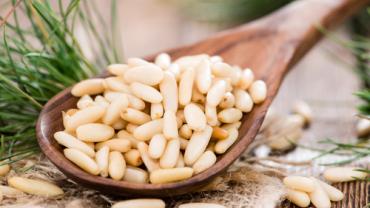
Pine nuts (or pignoli) certainly don’t seem to run the streets with common nuts such as almonds and cashews, but rather, they appear to be a more exquisite nut, regarded as an adornment to gourmet dishes. They would certainly be classified as elite, a category supported by their price tag. But don’t let the price scare you away, since pine nuts can impart health benefits worth mentioning.
Despite their name, pine nuts aren’t really nuts at all. They are seeds of pine trees and found hiding between the cones. Once shelled, they rapidly become rancid because of their oil content, so they must be stored appropriately or enjoyed quickly.
Nutrient Profile
There are a few nutrients in pine nuts that really shine, compared to other nuts and seeds. First, pine nuts carry more manganese than any other nut or seed. Giving 123 percent of the RDA (or 2.5 mg), per ounce, pine nuts can offer some nice antioxidant benefits which we will visit in a bit. These seeds also contain 15.3 mg or 19 percent of the RDA for vitamin K, 2.65 mg or 13 percent of the RDA for alpha tocopherol, and 15.8mg of choline. However, one of their more impressive claims to fame is the phytosterol content. More specifically, an ounce of pine nuts supplies 37 mg of beta-sitosterol and 6 mg of campesterol.
Beta-Sitosterol & Cancer
Research on beta-sitosterol has most recently focused on its anticancer properties. Beta-sitosterol has been found to interfere broadly with cell signaling pathways such as the cell cycle, apoptosis, proliferation, survival, invasion, angiogenesis, metastasis and inflammation. Its actions make it useful against a wide variety of cancers, including breast, prostate cancer, colon, lung, stomach, and ovarian.
Not only does beta-sitosterol directly affect the cell signaling pathways, but its antioxidant properties potentiate its anticancer actions. Oxidative stress is widely recognized as a risk factor for cancer, and beta-sitosterol decreases reactive oxygen species while protecting and restoring the body’s natural enzymatic antioxidants, including catalase, superoxide dismutase, glutathione peroxidase, glutathione reductase, glutathione S-transferase, and reduced glutathione. Studies even indicate beta-sitosterol may be an effective chemopreventive drug.
Manganese & Aging
Manganese is not a mineral you see gracing many headlines, but it is a critical component of one of the body’s main antioxidant systems. Manganese superoxide dismutase (MnSOD) works in the mitochondria to modulate a majority of the body’s oxidative stress. As the mitochondria generates the reactive oxygen species, superoxide (O2-), MnSOD scavenges it before it accumulates and destroys neighboring cells and tissues. Downregulation of the SOD pathways are associated with heart and brain health risks, and a lack of MnSOD, particularly, is linked to carcinogenesis, as well as metabolic and cardiovascular risks.
Cardiovascular health risks appear to stem from vascular aging, caused by oxidative stress. Moreover, free radicals can be generated by aging vessels. MnSOD is often downregulated as a result of aging vasculature and contributes to chronic oxidative stress and inflammation. Keeping MnSOD levels high by supplying adequate manganese can help prevent the aging of vessels and associated cardiovascular disease.
MnSOD is also downregulated as a normal part of the aging process, but antioxidants such as manganese can help maintain genetic expression of this antioxidant and prolong lifespan. Nearly all connective tissue contains MnSOD to modulate oxidative stress and aging. When MnSOD is lacking in these tissues, lifespan is reduced and aging processes such as weight loss, skin atrophy, kyphosis, osteoporosis, and muscle degeneration progresses.
Manganese is most often obtained through food sources, but recent research is indicating that our foods are quickly being depleted of this critical nutrient. The introduction of genetically modified Roundup® Ready seeds and the increased use of Roundup® herbicides spearheaded this problem. Glyphosate, the active component of Roundup® severely depletes manganese levels in many of our core crops, among its other numerous health catastrophes. As our intake of this mineral diminishes, so does Lactobacillus, a critical organism of our gut which relies on manganese for survival. Dysbiosis is only one consequence. Anxiety disorder, autism, mitochondrial dysfunction and numerous neurological disorders are associated with a deficiency of manganese because of the resulting overexpression of glutamate and ammonia. Although we may not hear a lot about manganese, its importance in aging and various health conditions cannot be ignored.
Pine nuts provide two critical nutrients not often supplied by many other food groups: manganese and phytosterols. These nutrients give pine nuts their rightful place the world of superfoods. While they are most notorious as being the foundation of pesto, pine nuts’ great flavor makes them a wonderful addition to many recipes, including many side dishes and savory salads.